The Earliest Images of Saharan Rock Art Are Thought to Date From at Least
African art history
African art history has played a meaning role in shaping the civilization and history of the world. The conventionalities that Africa is the cradle of the history of flesh is virtually unshakeable. The origins of African art history lie long before recorded history, preserved in the obscurity of time. Rock Art is centuries old, while crush beads fashioned for a necklace accept been recovered in a cavern in the furthest reach of the southern peninsula of South Africa that are 75 000 years one-time.
A report of African art history indicates the earliest sculpture forms plant come from Nigeria and are dated effectually 500BC. However, the lack of archaeological excavations inhibits cognition of the antiquity of African art and the sheer dispensable nature of the raw materials used in the creation of art objects means that an untold wealth of pieces have disintegrated in time.
Compounding this, as these objects were non coveted as aesthetic accomplishments by the indigenous communities who created them, no endeavour was fabricated to preserve them. Often their value was negligible once their office was performed.
Foreign colonisation of virtually countries in sub-Saharan Africa took identify from 1840 onwards and unlike values became omnipresent. A lot of African art was acquired for curious ways by travellers, traders and missionaries in the century before and left the continent. Colonialists most often did non give indigenous art the merit and attending it deserved and thereby African art history was non preserved or documented.
There has been a huge emphasis on Fundamental African art history for two reasons, ane being that the communities who resided in that location were the most sedentary of the tribes in Africa and secondly, that they produced figurative sculptures that Western collectors could almost hands identify with as 'art'; as they defined it.
The bones bailiwick is the human figure and strong formal qualities were exhibited with strong pattern features creating balance and harmony. These formal design qualities combined with a powerful spirituality and expressive vigour attracted early on twentieth century artists to explore new dynamics in visual art and became the birthstone for mod twenty-four hours abstraction.
The surge in interest in collecting African fine art, both tribal and contemporary, has forced scholars and investors, governments and institutions to re-examine the very essence of African fine art. Collections that have been inhabiting deep, nighttime depths of museum vaults have been moved to the forefront of African fine art history museums, galleries and auction houses to be observed and celebrated for the beautiful and fascinating field of art that it is. European and African researchers are studying collections not only to see how they may be used to shed more light on African art history but besides to aid restore lost traditions and skills in the crafts of the cultures from whence they came.
Historically, some communities were non sedentary and would accept carried with them as picayune every bit possible and therefore just commonsensical objects would accept been transported. Because their value was based on their functionality and their spiritual attributes, should their purpose no longer be of service to the creator and his community, they would have been abandoned.
Africa must have lost uncountable pieces of fine art that would accept been lost on the wayside of migratory existence.
The ancestry of African art history
Stone fine art is the earliest art form in Africa.
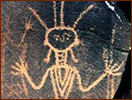 Round headed figure
Round headed figure
3000 BC, Niger
We know from homo evolutionary scientific discipline that mod Human Sapiens began in Africa. It stands to reason therefore that Africa would contain both the oldest and greatest amount of rock art on this planet.
The oldest images scientifically dated are in Namibia (the Apollo 11 caves) from most 24-27,000 yrs agone, yet most experts hold that Africa's rock art may appointment to more fifty,000 years ago.
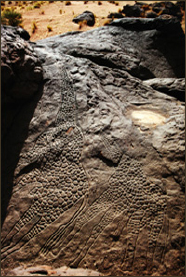 Giraffe engraving, Niger, Bradshaw foundation
Giraffe engraving, Niger, Bradshaw foundation
The earliest known rock art preserved in the Saharan sands in Niger dates as far back equally 6500 BC. They are carvings known as petroglyphs and describe animals like giraffes that no longer exist in that area.
From these images we learn how aboriginal tribes and cultures viewed their universe around them. Observing the paintings may give u.s. insight into their thoughts, their spiritual and physical worlds.
Unfortunately, much of this valuable heritage is being destroyed; either past natural erosion as the sites come under civilisation pressure or by graffiti defacing the rock canvases.
African art history presents a earth heritage nosotros demand to find a style to preserve.
Sculptures
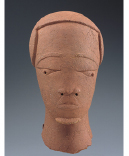 Nok head
Nok head
Northern Nigeria
500BC - AD500
The earliest known sculptures are the remarkable terra cotta pottery heads, most of them fragments of figures, from the Nok civilisation of Nigeria and are dated around 500 BC through to 200 AD.
They are made from grog and atomic number 26 rich clay but none of them have been found in their natural settings and they demonstrate that strong abstract figural representation has existed in Africa for over 2500 yrs.
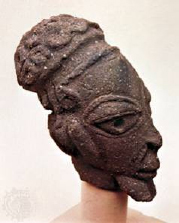 Jos museum, Nigeria. (The terracotta dirt skid has eroded away leaving a grainy pock-marked original surface)
Jos museum, Nigeria. (The terracotta dirt skid has eroded away leaving a grainy pock-marked original surface)
Their potent formal elements and expressive quality places them at the start of the African sculptural tradition. They are remarkable for their sense of caricature and accept a strong sense of manner showing elaborate hairdos and ornamentation.
Nok terracottas currently occupy an important but isolated space in African fine art history.
Past around the 1st C AD, figures of an intriguing severity are beingness produced in the Sokoto region of north western Nigeria. Sokoto itself is at the confluence of ancient trade routes. These figures tend to have heavier brows and are less ornamented than Nok figures, but at that place is undeniably a link even if we are yet to fully comprehend the connection between the two seemingly isolated cultures.
The fired, earthen ware Lydenburg heads were found in the same named commune in S Africa and it has been established that they were cached there in 500 AD making them the oldest known African artworks southward of the equator. Little is known of the ancient civilization that produced this group of 7 heads simply the careful manner in which they were buried reveals the significance and respect they had for the people who laid them under the ground.
The large furrowed rings around the cervix may bespeak prosperity and power only it can not be known for sure. We tin can only speculate and place them in context with what we know about African art history.
Terracotta sculptures have been unearthed by archaeologists in the area of Jenne in Mali and at Ife in Nigeria and date from 1000 to 1300 Advertizement. Powerful terracotta sculptures continued to be made throughout Africa in the 19th and 20th Centuries.
Stone sculptures exist from the Kongo people and the Sherbro from Sierra Leone dating no subsequently than the 16th C. Ivory was carved with great skill in Benin at the same time.
Metal sculptures and carvings
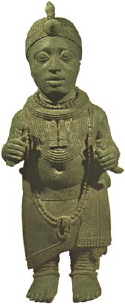 Contumely figure Oni (King)
Contumely figure Oni (King)
of Ife 14th-15th C
Cast metal is the only other cloth to withstand the continent's termites.
Dating dorsum to the 9th C AD is the bronze casting tradition of the Igbo-Ukwu tribe of Nigeria. Sites have revealed cast statuary regalia besides as other works of art.
This superb tradition reached its peak with the Ife people from Yoruba, Nigeria who began to produce very fine contumely and bronze castings in the twelfth C and continued to the 15th C. Life size heads and masks and smaller full-length figures achieved astonishing realism and reflected a tranquility intensity that was the forerunner to that quality which nosotros now admire then much in traditional African sculpture. Sometimes they too bandage in pure copper, technically much more challenging than brass.
From the 15th C fifty-fifty to today, the Yoruba people in Republic of benin created sculpted heads that today are known equally the Republic of benin bronzes simply are in fact made of brass which arrived in the form of vessels and ornaments on the merchandise route and melted down. In both these cultures their works were often produced for their Kings and had magical powers, reflecting their behavior and the socio-political organizations and chiefdoms which existed under the rule of a divine King or Ife.
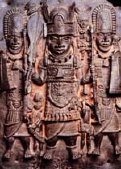 Brass plaque
Brass plaque
Benin, 16th
 Plaques, royal court
Plaques, royal court
The inflow of the Portuguese prompted Benin sculptors to produce brass plaques with scenes in relief. These plaques were nailed as decoration to the wooden pillars of the purple palace.
Textiles and weights
These 2 areas of fine art can as well give us some chronological order in trying to empathise the nature and time sequence of African art history. The earliest textile remnants are found again from Igbo-Ukwu and appointment to 9thC Advertizement while the Tellam caves in Mali were institute with cotton and woolen cloths preserved since the 11th C.
The Akan of Ghana manufactured small cast copper and bronze gold weights from the 18th C which came in all forms, animal, human, fruits, fifty-fifty abstract geometric shapes. They stood as little figurines, many less than 5cm high and expressed a liveliness and spontaneity not often found in African sculpture.
19th and 20th C African wood sculptures
Forest carving remains today the primary sculptural art course of the sub Saharan continent.
African art history shows the earliest wooden sculptures from the 17th C are attributed to the Kuba, cardinal Zaire only the earliest surviving sub-Saharan sculpture is a zoomorphic head found in 1928 in Cardinal Angola. It is dated to the 8th-9th C and survived existence cached under the water table.
The finest examples of surviving wood carving date effectually 1920, some nerveless as early equally 1890 and generally gathered before 1945 while tribal art was still very much in practise.
Influence on modern art and architecture of
African art history
At the commencement of the 20th C, many artists such equally Derain, Picasso, Matisse and Modigliani became enthralled past African fine art and began to visit the Trocadero museum in Paris to gaze upon the unique forms, absorbing all that was presented before them.
These artists saw in this art a formal perfection countered by abstraction, disproportion by residuum, primitivism with sophistication of design. They responded to this raw expressive power with all their faculties, non only with sight but with imagination and emotion and experienced a mystical and spiritual encounter.
This assimilation exploded in a fascination in abstraction, system and reorganization of forms, and the exploration of emotional and psychological areas that had not been investigated before. Information technology helped them motility beyond the naturalism that had divers Western art up to this indicate.
Now, the status of visual art was inverse forever and Cubism was born, influenced by the African sculptor's simplified use of planes and forms and the rearrangement of homo grade that was based, in fact, on disproportion.

Picasso and the other group of advanced artists from the 'School of Paris' began themselves to collect tribal sculptures and artefacts that were beginning to appear in peachy numbers in Paris as a upshot of French colonization in Africa. Picasso incorporated the ceremonial masks of the Dogon tribe into his groundbreaking piece of work similar Les Demoiselles d'Avignon, (1907-1909) and the influence of his Gabon masks he caused is also seen in his white sculpture, Head of a Woman (1929-1930).
Modigliani was singular in his adaptation of the stylistic influences of the work of the Baule tribe, from the Ivory Declension. Brancusi adopted not then much the form merely the use of wood as a sculpting medium just equally on the other side of the earth in America, sculptors such as William Zorach and Chaim Cross rejected Rodin's cast-statuary stronghold in favour of direct carving in woods.
Matisse was influenced not only past the sculptural forms of African art but also past the handcrafted textiles he, as a fellow member of a family of generational weavers, was drawn to Kuba cloths from the Congo, in detail, with their allover patterning became inspirational for his paper cutouts with their perspectival shifts. He noted that his impulsive use of bold color stirred the emotions and related to the ritualistic origins of African Art.
In architecture, two new principles had radical influence on design. I was the visual effect of decorative patterning on surfaces, well-nigh notably outside walls and the other was a new mental attitude to spatial environments, spaces that do not just conform to human being size, to role and form but too to the psychology of human nature.
Architects such as Le Corbusier and Oscar Niemeyer expressed themselves giving brutal class to structures and monumentalized buildings. They introduced long linear vertical lines and embellished their structures with textured murals and large bas-reliefs based on the nonlinear scaling of geometric shapes that is particular to African ornamentation.
African art history has had untold influence on the global art world.
Source: https://www.contemporary-african-art.com/african-art-history.html
0 Response to "The Earliest Images of Saharan Rock Art Are Thought to Date From at Least"
Post a Comment